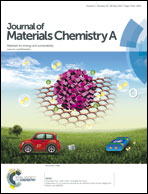Understanding the effects of electrochemical parameters on the areal capacitance of electroactive polymers†
Abstract
A number of variables contribute to the electropolymerization, and the electrochemical properties, of electroactive polymers. However, few studies have attempted to acquire a unified understanding of the effects of all these variables, specifically as it relates to the capacitance of the material, as the number of experiments and resources required is large. Here, the effects of seven variables on the areal capacitance of the electropolymerized dimethyl derivative of poly(3,4-propylenedioxythiophene) (PProDOT-Me2) films are analyzed utilizing a fractional factorial design of experiments to reduce the number of experiments an order of magnitude. From this analysis, PProDOT-Me2 films were electropolymerized from an optimal set of variables to reproducibly afford films displaying the highest capacitances observed within this study. Devices were assembled from the optimized conditions, and the capacitance, energy, and power densities are reported in a framework that allows for meaningful comparison and understanding relative to commercially available supercapacitors. The supercapacitors fabricated in this study show promise towards being integrated as power sources for low-power, lightweight and flexible organic electronic devices.


 Please wait while we load your content...
Please wait while we load your content...